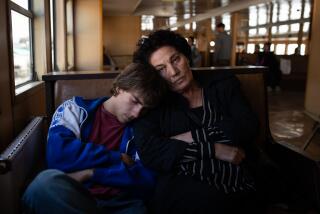Market Scene : Cashing in on Glasnost in a Remote Corner of Turkey : Soviet Georgians are streaming over the border to pick up cheap jeans and consumer goods. In doing so, they’re restoring trade links that were cut during Stalin’s time.
- Share via
CAMLIHEMSIN, Turkey — The browned, flaking picture of the state funeral of Kemal Ataturk, founder of the Turkish Republic, had been pinned to the mountain chalet’s wooden wall more than 50 years ago.
Yet, for the elderly Turkish woman in an orange-and-black head scarf who sat below the poster, that 1936 event, attended by a Nazi leader with a swastika armband and European dignitaries with ostrich-feather plumes, almost counted as modern times.
“This house was being built before the Russians came and went (in 1915-17),” she said with a sigh. “The master carpenter went off to the war. He never came back.”
Time, in fact, seems to have stood still throughout this northeastern corner of Turkey ever since the troubled first years of this century. Natural trading and cultural links to the neighboring Soviet republic of Georgia were cut when Josef Stalin closed the border in 1937. Then came the Cold War, during which Turkey threw in its lot with the North Atlantic Treaty Organization and this region was further isolated.
But the ripples from the revolutionary changes in the Soviet Union are finally beginning to reach even this remote region, bringing the beginnings of a “peace dividend” to a corner of the world where inhabitants of some neighboring villages still communicate by whistling.
To the east, the Soviet-Turkish border was reopened less than two years ago at Sarp, a Black Sea fishing village which had been split down the middle by wire and watchtowers for more than half a century. After the first family reunions and an initial trickle of visitors, traffic has at last started to pick up.
More than 7,000 Soviet citizens visited Turkey in the first two months of the year--more than three times the number who came in the same period in 1989. Most cross from Soviet Georgia by the bumpy road along the northeastern coast, where frequent rockfalls have defied attempts to widen and improve the road.
“The whole Soviet population seems to want to come,” said Rifat Guney, who manages Sarptur, a northeastern tour agency exploiting the new traffic. “Our Turkish consulate over the border in Batum says it has already given 32,000 visas this year. The queue for Soviets at the border can tail back one week.”
Freshly painted signs in runic Georgian script are already up to entice the new visitors into northeast Turkish gas stations and shops as far west as the regional capital of Trabzon. As soon as the Georgians stop their small Lada and Moskvitch cars, knots of Turks cluster around to see what can be bought or bartered.
An amazing variety of goods are brought out of the car trunks. Vodka, thermometers, electric razors and even blood pressure-testing equipment are all snapped up, with many locals unable to resist the bargain prices. In return, Georgians--just like other East Europeans now streaming to Istanbul over Turkey’s western border with Bulgaria--want cheap jeans and consumer goods churned out by Turkey’s booming economy.
“I feel ashamed doing this,” said Lili Daushvili, a Georgian schoolteacher from Tbilisi, as she pushed a throng of Turks away from her car trunk with distaste. “But the Russians won’t let us carry out any money. This is the only way we can raise some cash.”
Northeastern Turkish business leaders hope this border commerce will help them join the recent exponential growth of Turkish-Soviet trade, in which exchanges are expected to hit $2 billion in 1990, four times the 1986 level.
The Turkish government hopes that its strategic position on NATO’s front line will, in the aftermath of the Cold War, be transformed into easy access to southern Soviet and East European markets.
Expressing a still undefined concept of a newly industrialized Turkey reaching out to the smaller republics slowly being freed by Moscow, President Turgut Ozal speaks of a coming “Black Sea economic zone.”
But other than the roadside car trunk sales, barter trade here on the northeastern border is still in its infancy. Local Turkish businessman Yavuz Karahan said it amounts only to some Soviet coal and plate glass in one direction and, in the other, a Turkish bread-bakery oven.
“Our hopes were slow to be realized,” said tour operator Guney. “But at least tourism is finally booming now. Georgians are waiting a week at the border to try to get across.”
The flow of Turks to Georgia is less dramatic. Some tour operators report the main interest is from Turkish men happy to spend $50 a night for a Georgian woman.
A few intrepid foreigners are showing up in the border traffic as well. Soviet Georgia is already tourist-oriented. But despite the boom in tourism in Turkey this decade, last year only about 5,000 foreigners aimed for the dramatic natural beauty of its northeastern corner: back-packers, mountain hikers, white-water canoeists and hunters for boar and bear.
The mountains that surge dramatically out of the Black Sea in this region, the so-called Pontic Alps, are relatively accessible from Europe but retain a wild, trans-Caucasian feel. They are home to hazelnut farmers, tea growers, and cattle breeders.
Electricity is arriving, it is true; but hundreds of villages like this one, with its flaking picture of Ataturk’s funeral, can still be reached only after long walks on steep mountain footpaths. Oxcarts with solid wooden wheels still take villagers up to summer pastures, and the hides of freshly shot wolves and bears are nailed to the walls of inns. It is a land of deep gorges; one village communicates with its neighbor across the chasm by a language of whistles.
Often a minaret or ruined 1,000-year-old Georgian church lost high on a mountainside is the only sign of human habitation.
The people here are an extraordinary patchwork of bloodlines that converted to Islam in recent centuries. Neighboring mountain valleys may harbor Georgian farmers, Armenian-speaking villagers and Greek-speaking descendants of the Pontic empire. The eastern coast belongs to the Laz, a bright-eyed Caucasian people thought to descend from the Colchis nation that, according to myth, fought the Argonauts who came here with Jason to find the Golden Fleece.
Since the border opened in 1988, Georgian dance troupes have been invited here to entertain. Their Cossack-style leaping is instantly recognizable as a close cousin to the dances on the Turkish side of the border.
But these and other rediscoveries of shared ethnic links with Soviet Georgia are mainly symbolic for the moment, as are Turks’ special feelings for more than 50 million people of Turkic origin in other parts of the Soviet Union.
Turkish businessmen are wary of predicting how things will proceed. Some fear the fierce nationalism of the Georgians, a sharp slowing of Soviet commercial debt payments and, in Georgia, slumping industrial production. Economic memories go back a long way in the Turkish northeast.
“Many mansions here were built with money earned in Russia before the First World War,” said Savas Guney, a mountain guide near Camlihemsin whose grandfather went to Moscow as a pastry cook. “People invested heavily in Russian securities. Our valley lost whole fortunes in the Bolshevik Revolution.”
More to Read
Sign up for Essential California
The most important California stories and recommendations in your inbox every morning.
You may occasionally receive promotional content from the Los Angeles Times.













